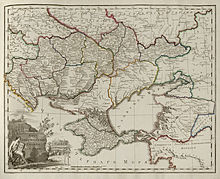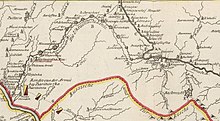
Back Наварасійская губерня BE Новорусийска губерния Bulgarian Gobernación de Nueva Rusia Spanish Uuden Venäjän kuvernementti Finnish Gouvernement de Nouvelle-Russie French Governatorato de Russia Nove IA Kegubernuran Novorossiya ID Governatorato della Nuova Russia Italian 노보로시야현 Korean Gouvernement Novorossiejsk Dutch
This article includes a list of general references, but it lacks sufficient corresponding inline citations. (October 2010) |
| Novorossiya Governorate Новороссийская губерния | |
|---|---|
| Governorate of the Russian Empire | |
| 1764–1783 1796–1802 | |
 General-Governorate of New Russia in 1800 | |
| Capital | St Elizabeth Fort (1764) Kremenchug (1765–1776) Yekaterinoslav (Novorossiysk) (1776–1783) |
| Demonym | New Russian |
| History | |
• Established | 22 March 1764 |
• First disestablishment | 1783 |
• Reestablished | December 1796 |
• Disestablished | 1802 |
| Political subdivisions | provinces, uyezds |
| Today part of | |



Novorossiya Governorate[a] was an administrative-territorial unit (guberniya) of the Russian Empire, which existed in 1764–1783 and again in 1796–1802. It was created and governed according to the "Plan for the Colonization of New Russia Governorate" issued by the Russian Senate.[1] It became the first region in Russia where Catherine the Great allowed foreign Jews to settle.[1]
Most of its territories belonged to the Zaporozhian Sich as well as the Poltava Regiment and Myrhorod Regiment of the Cossack Hetmanate. Its establishment was strategically successful and advantageous for Russia, and after the conclusion of the Russian war against Turkey in 1774 it gave a way for Russia to access the Black Sea and establish an area that became known as Novorossiya ("New Russia"). It was created based on the Military Frontier of the Austrian Empire against the Ottoman Empire and involved many military units from the region that were resettled in Ukraine. The military units included mounted cossacks (or hussars) and mounted pikers (or lancers).
In 1796, the governorate was reestablished, but with the centre not in Kremenchug but in Yekaterinoslav, and in 1802 was split into three governorates: the Yekaterinoslav Governorate, the Taurida Governorate, the Nikolayev Governorate (known as the Kherson Governorate from 1803).
Cite error: There are <ref group=lower-alpha> tags or {{efn}} templates on this page, but the references will not show without a {{reflist|group=lower-alpha}} template or {{notelist}} template (see the help page).
- ^ a b New Russia Governorate at the Encyclopedia of Ukraine
